The USMC is Filled with Liars--The British Pioneered Amphibious Warfare, Not Them
By Mike Sparks
One of the manifestations of American triumphalism and exceptionalism is the constant stream of unsubstantiated boasts--lies emanating from its marine corps--which should be disbanded immediately for criminal negligence, incompetence and deceit because of a lack of fundamental cultural factual integrity. The continued existence of the USMC bureaucracy ruins any chance of inter-service co-operation and sucks up vast sums of monies on an obsolete approach to warfare perpetuated by incompetent narcissists who refuse to factually adapt.
No One's Going Ashore: USMC Landing Craft Incompetence
Let's begin with landing craft.
The British--not the lying USMC braggerts created amphibious warfare.
http://wapedia.mobi/en/Landing_Craft_Assault
The history of
The costly failure of the
The No Armor Protection, No Excuse
Most everyone knows that in WW2 American marines took heavy casualties when their unarmored wooden Higgins boats landed on beaches; the Spielberg movie "Saving Private Ryan" shows U.S. Army Soldiers on D-Day landing without smokescreens in unarmored wooden boats--where no USMC units took part--getting similarly creamed.
THIS DID NOT HAPPEN TO THE BRITISH ON D-DAY BECAUSE THEY ARMORED THEIR LANDING CRAFT. They were also STEALTHY. Unlike our Higgins boat deathtraps which we pontificate about endlessly in museums and books ad nauseum. [1]
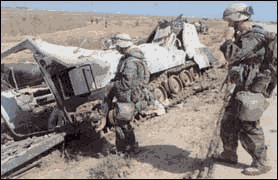

The Landing Craft Assault (LCA) was a
landing craft used extensively in the Second World War. Its primary purpose was to ferry troops from transport ships to attack enemy-held shores. The craft derived from a prototype designed by John I. Thornycroft Ltd. During the war it was manufactured throughout the United Kingdom in places as various as small boatyards and furniture manufacturers. The design was also produced in Commonwealth boatyards in the Far East.Typically constructed of
hardwood planking and selectively clad with armour plate, this shallow-draft, barge-like boat with a crew of 4, could ferry an infantry platoon of 31, with space to spare for 5 additional specialist troops, to shore at 7 knots (13 km/h). Men generally entered the boat by walking over a gangplank from the boat deck of their troop transport as the LCA hung from its davits. When loaded, the LCA was lowered into the water. Soldiers exited by the boat's bow ramp.The LCA was the most common British and
Commonwealth landing craft of the Second World War, and the humblest vessel admitted to the books of the Royal Navy on D-Day. [1] [2] Prior to 1942 these craft were referred to as 'Assault Landing Craft' (ALC), but 'Landing Craft; Assault' was used thereafter to conform with a name rationalization agreement among the Allied Navies. [3]Landing craft could hardly be adored by soldiers required to endure rides in them through any sea conditions. Still, the design's sturdy hull, load capacity, low silhouette, shallow draft, little bow wave, and silenced engines were all assets that benefited the occupants. The extent of its light armour, proof against rifle bullets and shell splinters with similar ballistic power recommended the LCA. Also, many a Tommy and GI looked favourably upon the luxury of seating in the well for the Soldier passengers. Throughout the war in the Atlantic, the Mediterranean, and the Indian Ocean, the LCA was the most likely sea assault transport of British Commandos, United States Army Rangers, and other Special Forces.
The LCA had a long central well section fitted with three benches, one centre, one each port and starboard, for seating troops. The side benches were covered by the top deck. The well was divided from the bow by a bulkhead fitted with two vertically hinged doors. This pair of forward-opening armour-plate doors lead to the ramp, which was lowered and raised by a simple arrangement of pulleys and wire. Two rollers on the leading outboard edge providing some freedom of movement for the ramp when it was grounded. Over this ramp troops could come ashore in two to three minutes, or less if the soldiers and crews were well trained. Immediately behind the bulkhead were the steering shelter on the starboard, and the
Wapedia notes:
More than a dozen LCA played a part in evacuating the BEF from Dunkirk (Operation Dynamo). The LCA were sent to Dunkirk on a merchant ship,Clan MacAlister. Designed to be hoisted on the standard passenger liner davits used for the 99 man lifeboats, the LCA could be carried and launched from a large number of Merchant Navy vessels. [32]
Now you might say, "ho-hum, that was WW2".
Sorry, but the USMC's nanny, the U.S. Navy (USN) supplied landing craft of TODAY are also not armored and require expensive, flooding well deck ships to launch/recover them. The shallow draft LCUs/LCMs/LCVPs are unchanged from WW2 designs except in size. The LCAC hovercraft is loud and vulnerable to easy enemy knock-out despite feeble attempts at piecemeal armoring. The USMC's owned and operated amphibious tractors (amtracks) are bloated because the headquarters marine corps (HQMC) bureaucracy doesn't want to invest in having more marines as vehicle crewman than pedestrian rifleman as SMALLER squad-sized amtracks would entail, choosing instead LARGE amtracks to transport more men making them HUGE TARGETS easy to spot and direct a guided missile into them and cannot be flown over sea mines or beach obstacles by heavy lift helicopters:
www.combatreform.org/amphibiousinfantrytanks.htm
No Firepower, No Excuse
Firepower from USN LCUs/LCMs/LCVPs/LCACs (the former are still in use on LHAs that have a divided flooding well deck) are weak or non-existent. At best some unstabilized machine guns that will hit nothing as they pitch in the water while stable enemy fire could cut into them and kill/wound/set fire/explode everything and everyone inside. A mere squad of men with "AK-47s" (AKMs), RPGs and a mortar could inflict serious and heavy casualties upon a marine rifle company coming ashore in current landing craft. Naval gunfire shore bombardment has evaporated due to USN aircraft carrier egotism so enemies on shore cannot be expected to be even suppressed much less cleared of likely beach landing sites. The USMC bureaucracy refuses to cough up the man-slots to the USN to man a pair of Iowa class battleships even on reserve status. So their trash talk that they value naval gunfire support is cheap.
www.combatreform.org/battleships.htm
Again, the British lead the way with converted landing craft with rockets and guns for fire support. What's our excuse today for not having these? We have none.
We are not even talking here of a fortified beach; we are just talking about a thin security screen of foot troops for early warning who even with their light weapons could devastate an USMC landing that came to them. If the security line is backed by Quick Reaction Forces (QRFs) with tracked tanks, the entire landing could be repulsed back into the sea like the Japanese were several times in the Philippines and at Milne Bay in 1942. The USMC excuse-monger will boast of their handfulls of marine tanks and aircraft countering enemy QRFs and this is BS; even the British with armored landing craft and very mobile Churchill medium tanks with long tracks backed by extensive RAF air strikes and naval gun bombardment were repelled at Dieppe the same year. Had German panzers been nearby in a QRF, it's likely NONE of the Dieppe raiders would have made it back to England.
No Mine Countermeasures, No Excuse
This is assuming the USMC can even get to the shore; the entire surf zone sea mine threat has been ignored by the USMC--which thinks it's not their job to overcome. The USMC is bent on hot-rodding in the high water speed EFV amtrack which has been a costly lemon resulting in soaring costs and fewer and fewer purchase numbers. The speedy amtrack is predicated on the USN failing to control the sea from the enemy and has to stay over-the-horizon to prevent from being sunk like British ships were in the Falklands war in 1982 when they had to venture in close in order to off-load slow landing craft:
www.combatreform.org/falklandslessonsnotlearned.htm
Yet, the primary problem is that FLIMSY SURFACE SHIPS without adequate numbers and types of aircraft are not-survivable on a naval battlefield dominated by precision-guided munitions (PGMs). The USN/Mc has known this since the end of WW2 yet they still persist in their flimsy surface ship Iwo Jima re-enactment racket:
www.combatreform.org/theendofflimsysurfaceships.htm
Still YEARS away from being fielded, the EFV has no counter-sea mine countermeasures and on land is fatally vulnerable to land mines with a flat bottom. Thousands of deaths and maimings in WW2, Korea and Vietnam has not resulted in any marine bureaucratic institutional knowledge that results in tangible progress; in fact the USMC is in REGRESS and is less capable than its WW2 forebears who were far less capable then to the British.
In WW2, the British fired Hedgehog mortars specifically to pre-detonate sea mines. Today, the USMC has no such weapon as if under a delusion that they no longer exist when in actuality they have increased in lethality many times over.
From the start, the Inter-Service Training and Development Centre intended to use armed versions of the LCA to provide close support to the troop-carrying types. These variants were armed with heavy machine guns and smoke-firing mortars. [14] The two prototype LCA from 1938 were converted for this purpose, and other, similar, conversions became the Mk. l LCS (M). [15] The Mk. 1 had a centrally located armoured steering shelter just fore of the engine compartment, and was armed with two .50 calibre machine guns, two .303 Lewis guns, and one 4" mortar or a 20mm gun. The crew of 11 included 1 officer, 3 ratings to sail, and 7 gun crew. The Mk. 2 was similarly armed on a standard LCA hull, except the two machine guns were in a twin turret rather than single mounts. [9] These craft were not expected to beach and later in production boats were given a proper bow, making them more seaworthy. Thus the LCS(M)(3) was produced and stayed in production for the rest of the war. [9] The LCS(M)(3) used Scripps marine conversions of the Ford V8 engine and had 98 gal. fuel tanks. [12] The turret was armed with twin .50 cal. Vickers power-operated machine-guns. [12]
The LCA was used as the basis for 'Hedgerow', LCA(HR), another support weapon variant. The troop well was filled by a
No Stealth, No Excuse: Today's Speedboat Mentality Created in Peacetime Vacuum
Go to YOUTUBE and search for any of today's naval infantry, marines or commandos and you will see them speeding to beaches in rubber boats and combination inflatable and rigid hull boats. SPEED has become a sexy practice in nearly all the world's amphibious units BECAUSE NO ONE IS SHOOTING AT THEM because WE ARE NOT AT WAR. Sorry, al CIAduh. Iraq and Afghanistan are defacto imperial POLICING actions--not wars.
www.combatreform.org/imperialpolicing.htm
Imperialism (n): The policy of extending a nation's authority by territorial acquisition or by the establishment of economic and political domination of one state over its allies and over other nations. 2: The system, policies, or practices of such a government.
A case could be made that it's somewhat ok for reconnaissance and raiding (AKA "Commando") units like the USN SEALs to speed ashore; however these boats are LOUD and easy to visually spot by bad camouflage colors like BLACK on the BLUE sea as well as being NOT radar-invisible with a lot of metal in their structures. Even recon units like this simply may not make it to shore; to try to land large numbers of marines in a few bloated amtracks emulating noisy speed boats is asking for enemy-created disaster.
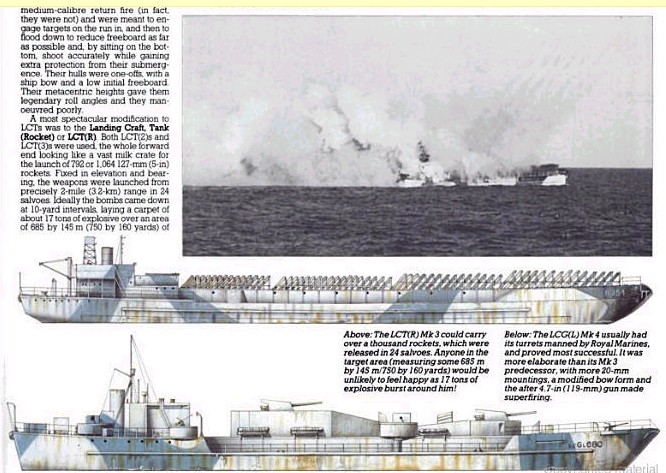
 www.youtube.com/view_play_list?p=A93EC383B70CA686
www.youtube.com/view_play_list?p=A93EC383B70CA686
One question I have is why the Royal Navy screwed over the Commandos by not providing a second destroyer to exfiltrate them for the St. Nazaire Raid? Armored LCAs could have darted in and out protecting the Commandos back to the second destroyer which could have provided fire support. Another sore point is why the RAF when cloud cover denied them military targets just flew around in circles alerting the Germans.
Mechanized Amphibious Assaults Are the Future
 www.youtube.com/watch?v=_qpN1VECZX4
www.youtube.com/watch?v=_qpN1VECZX4
It seems clear that what is needed is a SMALL, stealthy amtrack derived from plentiful M113 Gavins--"amphigavins" which can be FLOWN over sea mines by VTOL/STOL aircraft or cautiously sneak ashore launched from large transport seaplanes,
www.combatreform.org/seaplanetransports.htm
and heavily armored Iowa class battleship or submarine aircraft carriers that can off-load them near to shore;
www.combatreform.org/submarineaircraftcarriers.htm
Afterwards, men in small amtracks can surprise and overcome enemies with superior firepower and Hobart-style devices--true amphibious light mechanized warfare. The Russian Naval Infantry with their water-jet amphibious BMDs that are fixed and rotary-wing aircraft transportable are in the right direction.
www.lonesentry.com/manuals/commandos/commando-training.html
Motor landing craft (M.L.C.). 1 ft. 6 in forward; 4 ft. aft, loaded. 71/2 loaded. 40 ft. 13 ft. 6 in. 2 small vehicles, i.e., 15-cwt. trucks or Bren gun carriers, and 40 men; or 1 large vehicle, i.e., 3-ton lorry (truck) and 40 men; or 1 tank not exceeding 16 tons, and 100 men. If loaded with small vehicles, the M.L.C. can be lowered complete. If loaded with large vehicle, the M.L.C. must be lowered first and the vehicle lowered into her when she is afloat. Weight: 18 tons.
In WW2, the British executed mechanized amphibious warfare many times using Motor Landing Craft (MLCs) that could beach-deliver non-swimming light tanks up to 16 tons in weight that could still be carried and lowered by davits on the sides of nearly any ship--like destroyers---not just expensive, flooding well-deck amphibious ships the USN/Mc racketeers insist on having.
MLCs with 8-ton tracked, armored Bren gun "Universal" carriers
In fact, MLCs redubbed "Landing Craft Mechanized" (LCMs) were still small enough to be transported by TRUCKS INLAND and the larger American versions were used to ferry even 30-ton medium Sherman tanks across during Operation VERITABLE, the Rhine river crossing.
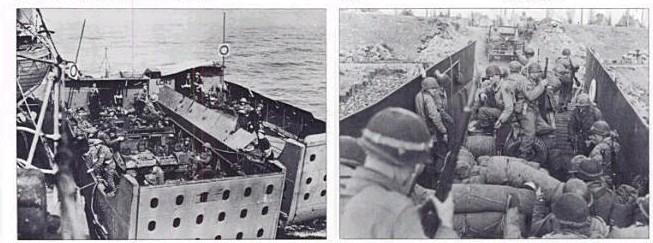

The Encyclopedia of Weapons of WWII: The Comprehensive Guide to Over 1,500 Weapons
http://books.google.com/books?id=MuGsf0psjvcC&pg=PA537&lpg=PA537&dq=%22Motor+Landing+Craft%22&source=bl&ots=K4ZEukSDfL&sig=p0C0QGaRD7jcmfhzMzaaw4uDAqA&hl=en&ei=DjQuTIXJJ8LflgfgkszhCg&sa=X&oi=book_result&ct=result&resnum=5&ved=0CBgQ6AEwBA#v=onepage&q=%22Motor%20Landing%20Craft%22&f=false
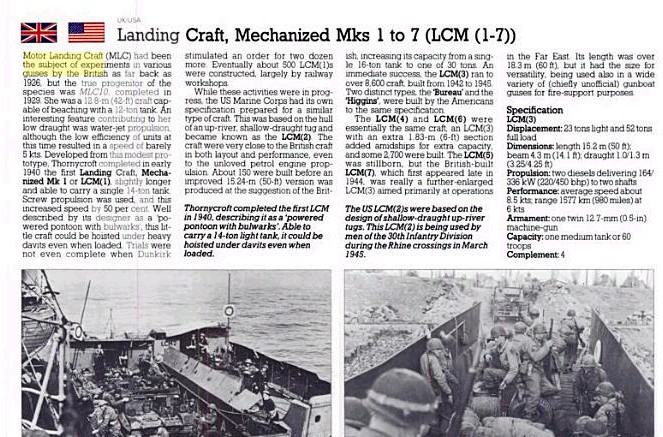
Death on the Beaches: No Maneuver if You are Dead
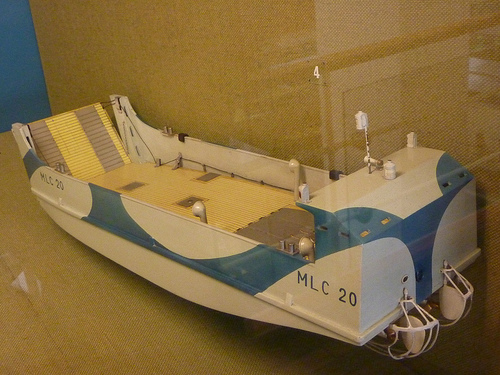
The USMC con artists will cite their embrace of snake oil salesman John Boyd's "OODA Loop" and Bill Lind's Maneuver Warfare Theories as the excuse-gospel-according-to-the-bureaucracy so that it need not be tangibly equipped and trained for mechanized amphibious warfare but can instead get by with staff plan ad hocery. Boyd talked about how being in a F-86 with a bubble canopy, we could out-think and out-fight, visually-impaired enemies in narrow canopy MIG-15s. The problem with his OODA-loop decision cycle mentality is YOU FIRST HAVE TO GET INTO THE "F-86" for it to work. There is no force structure "free lunch". The USMC doesn't want to work for and pay for with our tax dollars a sound mechanized, amphibious "F-86" force structure with which to do Boyd cycles. The USMC is a top-down, centralized bureaucracy of petty malignant narcissist assholes that are criminally incompetent wanting to relive WW2 badly. I know and admire Bill Lind and he does not support this abuse of his theory that by collecting intelligence on the enemy an EASY, WEAK spot to land can always be found and that from then on, the USMC can foot-slog with overloaded, initiative-less and frankly stupid infantry devoid of field craft, sound tactics, techniques and procedures (TTP) and battle drills. I know because I worked with him while a marine officer to redress the Soldier's load problem:
www.combatreform.org/combatlight.htm
We also know for mobile maneuver warfare (mechanized infiltration) to work ala the WW2 German blitzkrieg model the USMC--or any force---needs to be LIGHT TRACK MECHANIZED to be able to go cross-country at-will around say a Maginot Line defensive series of forts or simply not to bog down on the beaches. Yet, the lazy and malignant narcissist marines are increasingly buying WHEELED trucks with high ground pressures restricted to roads/trails that get stuck on soft sand beaches. Maximum cross-country, armored mobility is vital for success in both nation-state wars (NSWs) as well as sub-national conflicts (SNCs).
www.combatreform.org/ARMORHISTORY/index.htm
The USMC does not want to mechanize even to lay mats for its absurd wheeled vehicles; it will interfere with their garrison harassment games centered on vanity through uniforms, pretty barracks and lawn care and as soon as the duty day is over getting drunk and/or chasing women. The Army's light infantry narcissist units have their own "From Here to Eternity" garrison culture, too--but at least their field craft, TTP and battle drills are more developed stemming from at least some institutional humility forced upon them by Vietnam. For example, the bloated 13-man, 3-fireteam USMC squad where everyone is looking back at subordinate leaders and not the enemy is a "gaggle" that steers right into the enemy's guns, obstacles and mines predicated upon WW2 style heavy casualties during the beach landing. It also drives amtracks to be too large, though a small amtrack that can carry 13-15 men is still possible though unwanted by HQMC. The Army 9-man, 2-fireteam squad is far better; leaders focus on the enemy and everyone follows their example and it's not an unwieldy herd.
The British learned from Dieppe; the USMC did not from its debacle at Tarawa in 1943 a year later; to overcome beach obstacles they created COMBAT ENGINEERING TANKS AKA "Hobart's Funnies" using MACHINES not men:
www.combatreform.org/sappertanks.htm
Yet, the USMC persists in WW1-style pedestrian infantry assaults to take beaches--assuming these men can even reach shore. There is even a sub-branch of the malignant USMC maneuver warfare excuse-monger, the Luddite who wants to emulate a different set of Germans--the WW1 "Stormtroops" people like John Poole and Bruce Gudmundsson who essentially want to infiltrate on foot. Having worked with Bruce in the past, I know he somewhat wants the USMC to be mechanized, yet he is the author of the book on pedestrian stormtroop Germanophilia and has firmly ensconced himself into the safe past of WW1 in his books. [2] There is a problem with this; the British learned at Dieppe; if beach (or any) obstacles are properly covered-by-fire--you may not even get close on foot and exposed to lay an explosive charge. Poole who wants to emulate the NVA/VC sappers overlooks the HEAVY CASUALTIES suffered by throwing humans in waves however skilled, at minefields, wire and obstacles covered by enemy fire. A Third World Country "baby machine" on land can afford to throw people away like this, but a marine corps with only a few hundreds or few thousands of men per ship traveling from thousands of miles away from America cannot. The British stung by MILLIONS of men lost in WW1 and WW2 realized it must use ECONOMY OF FORCE via mechanization to finish off and win WW2. Apparently Americans have yet to lose enough men in wars to change its war-glorifying narcissistic ways. The USN/Mc want to re-enact WW2 badly--but without the massive draft of civilians into cannon fodder numbers--with relatively small groups of volunteer narcissists with LESS weaponry and enabling means. As a fellow marine officer put it; "the marine corps can't decide if it wants to be commandos or a second land army; so it does neither!".
Even if the USMC WW1 re-enactment somehow gets marines to the beach against say light or no opposition, the men are still foot-slogging and can be easily bypassed or destroyed by enemy mechanized forces if the former's crutch of American air supremacy is taken away from them. British general Francis Tuker warns of this constantly in his book, The Pattern of War, that ironically is an USMC publication--oh that marines would even read it!
www.combatreform.org/thepatternofwar.htm
The USN/Mc and Air Force are working very hard to emasculate themselves so we will not have air superiority in the next war by their ego and greed racketeering to fly only sexy fighter-bombers like F-35 fighter-bombers and not the varied types required:
www.combatreform.org/killerbees4.htm
www.combatreform.org/grasshoppersmustreturn.htm
Boydian Chuck Spinney's "death spiral" is happening now in aircraft; soon we will not have enough numbers to do much of anything on the still very large Planet Earth; we are unilaterally disarming ourselves due to greed and ego.
USMC Well-Trained? You Got to be Kidding; Compare to the British in WW2
British WW2 Commandos
VIDEOS
 http://www.youtube.com/view_play_list?p=494B4D054F2A3BD6
http://www.youtube.com/view_play_list?p=494B4D054F2A3BD6
www.lonesentry.com/manuals/commandos/commando-training.html
EXCERPT:
Practical and theoretical instruction in map problems was stressed. French, German, and Russian, as well as English, maps were used. Students were taught to make hasty sketches, perspective drawings of shore lines, and overlays.
Day and night, practical map problems that required mountaincraft and considerable physical exertion were worked out in the field. The average distance covered in these map problems was approximately 40 miles. The students had to contend with poor visibility, sleep in the rain, build fires with wet fuel, cross swift mountain streams, and move rapidly over exceedingly difficult terrain. In the beginning some students unfamiliar with the terrain and training were lost in the Highlands for as many as 3 days.
The use of ground and cover was taught practically in progressive stages. At first the students were required to move toward given objectives over terrain affording good cover; and when they exposed themselves unnecessarily, this fact was brought to their attention. In the later training, the facilities for cover were much more limited. In the middle stages of this work, blank cartridges were fired from an Enfield rifle when a student exposed himself unnecessarily. In the final stage, ball cartridges from rifles and Bren guns were fired so that the bullets fell 3 to 5 feet from such a student. This method produced excellent results, compelling the men to take cover naturally and quickly.
Another phase of training involved the use of canvas assault boats and reconnaissance boats. Practice in the use of this equipment was conducted in swift streams as well as in the sea. This training was further developed in the form of opposed landings, usually made before dawn, the students being required to fight their way to objectives situated from a few hundred yards to several miles inland. These objectives were usually high up the side of a mountain. During the attack, the men were subjected to very close fire from Bren guns and rifles as well as to the bursts of the Mills grenade, the bakelite grenade, and 2-inch-mortar smoke shells. This realistic instruction occasionally produced casualties. In one exercise one man lost an eye and another was cut severely in the leg by grenade splinters. On another occasion one man was killed. A combination of confusion and a strong desire to take cover quickly when under fire caused a number of sprained ankles and twisted knees. It was emphasized that these casualties were generally a result of carelessness.
Many hours were devoted to unarmed combat, involving ju jitsu, wrestling, and general brawling tactics. This training improved the individual's self-confidence and developed a keen desire to fight. Close combat proved highly interesting to both officers and noncommissioned officers. It was an excellent means of physical training, requiring the use of all the muscles and improving bodily coordination. The methods learned were actually employed in tank-hunting exercises and in taking fortified points.
A short course was given on the subject of tank hunting. Men were informed that determined individuals had been able to stalk and destroy tanks effectively in Africa, Norway, and Greece. Highly skilled stalkers are required, who must be aggressive to the point of recklessness.
In a typical problem at the Special Training Center, reconnaissance units located a park of dummy tanks before darkness. Although the park was guarded, the raiders were required to approach the tanks and destroy them without being seen. Usually the results were highly successful. Many parties reached their objectives either without being seen or after having quietly removed the guards in their path. The exercise demonstrated that soft-soled shoes must be worn, that helmets and any equipment which rattles must be left behind, and that knife fighting is effective against sentries. Men were taught that methods of hunting tanks must be varied to meet widely different concrete situations, and common sense was stressed as the basic rule in these exercises.
Orthodox and unorthodox use of grenades and mines for demolitions was taught, including techniques for the bangalore torpedo and the construction of booby traps with grenades. Instruction was also given in the employment of demolitions and explosives in conjunction with ambushes. Several accounts of actual ambushes contrived by commandos were studied and discussed, and a number of ambushes were set up in practice for the instruction of students.
Another subject in the course was the negotiation of obstacles. This included the crossing of barbed-wire barriers set up in German fashion, the crossing of mine fields, and the passing of booby traps and of natural and man-made obstacles of other types. The bangalore torpedo was employed to blast a path through wire. Other methods of crossing, such as the use of logs, gunny sacks, and blankets placed over wire, were demonstrated. A lecturer suggested that bodies of dead men might be employed effectively for bridging wire obstacles, and also that men wearing overcoats for protection against the wire could lie across entanglements so that other men could pass over them.
Two methods of crossing mine fields were taught. In one, students used bayonets to prod the ground until a mine was discovered. These were then dug out or exploded with guncotton. The other method was to use the cup projector in conjunction with an Enfield rifle and a Mills grenade. A 30-yard length of cordtex (explosive cord 1/4 inch in diameter) was coiled with one end tied to the Mills grenade (detonator removed). The grenade was fired across the mine field, dragging the cordtex approximately 30 yards. The cordtex was then detonated, causing all mines in a path 8 inches wide to explode. Ten feet to one side a similar exercise was carried out. Two men followed the paths of the exploded cordtex, dragging a net of cordtex with an 8-inch mesh, 10 feet wide, across the mine field. When the net was detonated, a 10-foot path was cleared. In a practice crossing in which a U.S. observer participated, every mine within the 10-foot path was exploded. The mines were the British Mark IV antitank mines.
Today's USMC Bullshit
www.amazon.com/Making-Corps-Thomas-Ricks/dp/0684848171
Today's marine is a weak-ego lemming obsessed with vanity and appearances geared towards bureaucracy and peer approval AKA: weak co-dependency. WW2 British commandos were empowered to THINK--not blindly conform to bureaucratic bullshit.[3] Their cultural foundation was and still is that each 2-man building block is based on FRIENDSHIP. The individual's strengths are to be nurtured not destroyed and made into a cog in a bureaucratic machine. The USMC is a BUREAUCRACY (like all the other U.S. military services)--not a PROFESSION. The British build PROFESSIONALS who THINK and put their best ideas forward where they are considered and acted on regardless of rank or social status---ironic when they are the ones who are not stereotypically snobby. The British have learned to build their military into a PROFESSION the hard way--by many military defeats over the years. In contrast, American marine defeats like Nasiriyah in 2003 and Beirut in 1983 are LIED AWAY by excuses and outright refusal to face FACTS such that unlike the British, experience does not make the USMC better.
USMC Debacle Nasiriyah in 2003 (Exactly on the 20-year anniversary of Beirut!)
 www.youtube.com/watch?v=Ha4x5c4xBFE
www.youtube.com/watch?v=Ha4x5c4xBFE
 www.youtube.com/watch?v=a10F5CBHAZE
www.youtube.com/watch?v=a10F5CBHAZE
There is a wonderful saying about the British military worth considering:
"The British always lose every battle--except the last one"
What this is saying is that they first have the HUMILITY to admit they will likely get it wrong. Even several times wrong. However, THEY ARE NOT GOING TO STOP UNTIL THEY FIND A WAY TO GET IT RIGHT AND WIN. There is no such humility and dedication to excellence in the BS con artist USMC. Because the USMC is a BUREAUCRACY--not a PROFESSION. Nearly all marines are brain-washed and buy into the BS fed them by the bureaucracy that "the bureaucracy knows best" and if they just STFU and blindly obey a magical form of herd effect will overwhelm any and all enemies by NUMBERS and mass. Its pure 19th century linear war, parade ground, cannon fodder crap. We have a 19th century USMIL in a 21st century world, yet wonder why we are getting our asses kicked constantly in places like Afghanistan and Iraq? Do a reality check! The fault is IN OURSELVES--not the stars.
The USMC shouldn't decide whether to be commandos or a second land army; it's already decided to be NEITHER.
We should decide for them that they should be abolished altogether since the whole outfit is corrupt from the get-go. We should start over with a NAVAL INFANTRY that is a part of the U.S. Army to insure inter-service co-operation and get a fresh start built upon a PROFESSIONAL culture with the British commandos as our guide to creating a true, light mechanized amphibious strike force.
NOTES
1. www.globalsecurity.org/military/systems/ship/lcm.htm
2. www.ospreypublishing.com/authors/bruce_gudmundsson/
3. www.lonesentry.com/manuals/commandos/index.html